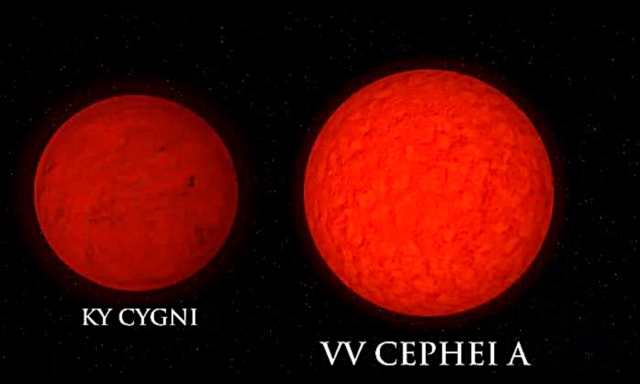Stars are huge balls of burning plasma. But, with the exception of the Sun, they look like tiny dots of light in the night sky. Moreover, our Sun is not the smallest or largest star. There are many much more massive and larger stars than the Sun. Some of them have evolved since their inception. Others grow as they age.
To answer the question of which star is the largest in the universe, we “sorted” the stars by such a sign as size. The equatorial radius of the Sun, which is 696,392 kilometers, was taken as a unit of measurement of stellar radius.
10. V766 Centauri
 This celestial luminary, also known by another name (HR 5171 A), belongs to the yellow hypergiants and is a double star. Its smaller "workmate" HR 5171 B revolves around the V766 Centauri for 1300 Earth days.
This celestial luminary, also known by another name (HR 5171 A), belongs to the yellow hypergiants and is a double star. Its smaller "workmate" HR 5171 B revolves around the V766 Centauri for 1300 Earth days.
9. VV Cepheus A
 This star is located in the direction of the constellation Cepheus, about 5 thousand light years from Earth. A red hypergiant with a radius of about 1050-1900 radii from the Sun is part of a binary star system. Her companion is the small blue star VV Cepheus B, which revolves around her "big brother" in an elliptical orbit. The name of the star is given in honor of the largest of the pair, and now it is known as one of the largest double stars of the Milky Way.
This star is located in the direction of the constellation Cepheus, about 5 thousand light years from Earth. A red hypergiant with a radius of about 1050-1900 radii from the Sun is part of a binary star system. Her companion is the small blue star VV Cepheus B, which revolves around her "big brother" in an elliptical orbit. The name of the star is given in honor of the largest of the pair, and now it is known as one of the largest double stars of the Milky Way.
8. AH Scorpio
 To get to know this red supergiant from the constellation Scorpio closer, people would have to cover a distance of 7400 light years. The radius AH of Scorpio exceeds the solar by 1411 times.
To get to know this red supergiant from the constellation Scorpio closer, people would have to cover a distance of 7400 light years. The radius AH of Scorpio exceeds the solar by 1411 times.
7. VY Canis Major
 This star is associated with heated debate among astronomers. According to estimates adjusted in 2012, its radius exceeds the radius of the Sun by 1420 times. However, according to an initial estimate by Robert Humphreys, the radius of VY of the Canis Major is 1800 - 2200 times that of the sun. The exact radius of the star giant has not yet been established. When it can be found out for sure, the leader in the ranking of the largest stars can change.
This star is associated with heated debate among astronomers. According to estimates adjusted in 2012, its radius exceeds the radius of the Sun by 1420 times. However, according to an initial estimate by Robert Humphreys, the radius of VY of the Canis Major is 1800 - 2200 times that of the sun. The exact radius of the star giant has not yet been established. When it can be found out for sure, the leader in the ranking of the largest stars can change.
6. KY Swan
 The radius of this hypergiant star is at least 1420 times the radius of the Sun, and the brightness level is already 300,000 times higher than the sun. It is located in the constellation Cygnus, at a distance of about 5 thousand light-years from Earth.
The radius of this hypergiant star is at least 1420 times the radius of the Sun, and the brightness level is already 300,000 times higher than the sun. It is located in the constellation Cygnus, at a distance of about 5 thousand light-years from Earth.
5. VX Sagittarius
 This star belongs to the class of hypergiants - the most powerful and brightest, the heaviest, and at the same time the rarest and short-lived supergiants. Its radius exceeds the solar about 1520 times.
This star belongs to the class of hypergiants - the most powerful and brightest, the heaviest, and at the same time the rarest and short-lived supergiants. Its radius exceeds the solar about 1520 times.
VX Sagittarius is located in the constellation Cepheus, 9000 light-years from our planet. It is so huge that it can easily cover the orbital path of Saturn, if it is in place of the Sun. The red color of the star indicates that its temperature range is from 3000 to 4000 on the Kelvin scale. Hotter stars are yellow in color, while very hot ones take on a bluish tint.
4. Westland 1-26
 At a distance of 11,500 light years from our planet, in the star cluster Westerland 1, is the fourth largest star in the galaxy. In luminosity, it exceeds the Sun by 380 thousand times, and if placed in the place of our yellow luminary with its photosphere, it would absorb the orbit of the largest planet in the solar system - Jupiter. The photosphere is where the star becomes transparent to light, and where photons can disappear - that is, light particles. The photosphere allows astronomers to approximately learn about the "edges" of a star.
At a distance of 11,500 light years from our planet, in the star cluster Westerland 1, is the fourth largest star in the galaxy. In luminosity, it exceeds the Sun by 380 thousand times, and if placed in the place of our yellow luminary with its photosphere, it would absorb the orbit of the largest planet in the solar system - Jupiter. The photosphere is where the star becomes transparent to light, and where photons can disappear - that is, light particles. The photosphere allows astronomers to approximately learn about the "edges" of a star.
3. RW Cepheus
 Here is another star known to science from the constellation Cepheus got into the list of the largest. The radius of this red supergiant is about 1,600 solar radii. If RW Cepheus were in place of the Sun, the radiating layer of its stellar atmosphere (photosphere) would extend beyond the orbit of Jupiter.
Here is another star known to science from the constellation Cepheus got into the list of the largest. The radius of this red supergiant is about 1,600 solar radii. If RW Cepheus were in place of the Sun, the radiating layer of its stellar atmosphere (photosphere) would extend beyond the orbit of Jupiter.
2. WOH G64
 The second largest star in space is located in the constellation Golden Fish, 160 thousand light-years from our world. Despite the fact that this star lost up to a third of its original mass due to stellar wind, a long-term thick annular layer of gas-dust torus formed around it. The "dimensions" of the star were adjusted taking into account all the mass present in its ring. She is expected to become a supernova in a couple of thousand years.
The second largest star in space is located in the constellation Golden Fish, 160 thousand light-years from our world. Despite the fact that this star lost up to a third of its original mass due to stellar wind, a long-term thick annular layer of gas-dust torus formed around it. The "dimensions" of the star were adjusted taking into account all the mass present in its ring. She is expected to become a supernova in a couple of thousand years.
1. UY Shield (UY Scuti) - the largest star in the universe
 At a distance of 9500 light-years from the Sun, in the constellation Shield, is the largest star in the world. Its approximate size is almost eight astronomical units, where one astronomical unit is the distance between the Earth and the Sun. This is enough to extend the photosphere of the UY Shield into the orbit of Jupiter.
At a distance of 9500 light-years from the Sun, in the constellation Shield, is the largest star in the world. Its approximate size is almost eight astronomical units, where one astronomical unit is the distance between the Earth and the Sun. This is enough to extend the photosphere of the UY Shield into the orbit of Jupiter.
 The UY Shield is so gigantic and so bright that you can see it with powerful binoculars on a dark night. It is visible along the stars of the Milky Way, and looks like a reddish star with a faint spot.
The UY Shield is so gigantic and so bright that you can see it with powerful binoculars on a dark night. It is visible along the stars of the Milky Way, and looks like a reddish star with a faint spot.
Supergiant Learning
In the summer of 2012, astronomers, using the Very Large Telescope complex located in the Atacama Desert in Chile, measured the parameters of three red supergiants near the area of the Galactic center. The objects of study were UY Shield, AH Scorpio and KW Sagittarius.

Scientists have determined that all three stars are 1000 times larger and more than 100 thousand times brighter than the Sun. They also made the discovery that UY Shield is the largest, brightest of all three stars. An effective temperature of 3665 ± 134 K was obtained from the radius and luminosity.
Mass and dimensions of UY Shield compared to the Sun
The exact mass of this star is unknown, primarily because it does not have a visible satellite star, due to which its mass can be measured by studying gravitational interference. According to stellar evolutionary models, the initial mass of a star (when it is formed), corresponding to a red supergiant stage, such as that of UY Shield, would be about 25 M возможно (possibly up to 40 M не for a non-rotating star) and would constantly burn out. Presumably, its current mass is 7-10 M☉ and continues to decrease. UY Shield is not only the largest, but also the fastest burning star of the currently known science.

The mass of the UY Shield is slightly more than 30 times the mass of our Sun, which does not even approach the top of the list of the most massive stars. This honor belongs to the star R136a1, which is 265 times larger than the Sun in mass, but at the same time in radius only 30 times the radius of the Sun.
Mass and physical dimensions do not always correlate for celestial bodies, especially for giant stars. Thus, although the UY Shield is only 30 times more massive than the Sun, it has a radius somewhere around 1700 times the radius of our daylight. The error of this measurement is about 192 solar radii.
Is life possible near UY Scuti
The habitable zone or orbital zone with the highest probability of life is a complex thing, the possibility of which depends on several factors. The planet on which life was born should not be too far or too close to the star. According to astronomers, the habitable zone around the UY Shield will be from 700 to 1300 astronomical units (AE). This is an insanely long distance. The number in kilometers is simply incomprehensible - it is about 149 597 870 700 km. For comparison: the habitable zone in the solar system is at a distance from 0.95 to 1.37 AU from the sun.

If a living planet is at a safe distance, say, 923 astronomical units from the UY Shield, the year on it will last 9612 Earth years. It is almost 2500 years of winter! And 2500 years of summer. That is, many generations that know only one time of the year will be replaced.
The UY Shield may indeed have a planetary system in this zone, but if this happens, it will not exist for a very long time. You, the reader, can reasonably ask: “Why?” Because the future of the star is too bright.
What awaits the star in the future
Based on modern models of the evolution of stars, scientists suggest that the UY Shield began to merge helium into the shell around the core. As helium expires, the star will begin to merge heavier elements such as lithium, carbon, oxygen, neon, and silicon. The location of the star in the depths of the Milky Way suggests that it is rich in metal. After the fusion of heavy elements, its core will begin to produce iron, upsetting the balance of gravity and radiation, which will lead to the appearance of a supernova. This will happen in a million years - not very long by astronomical standards, but humanity has time to prepare for such an enchanting spectacle.
After the supernova, the UY Shield will most likely turn into a yellow hypergiant, a blue variable star, or even a Wolf-Rayet star with very high temperature and luminosity. In the latter case, she will “give birth” to many new stars after her supernova.












